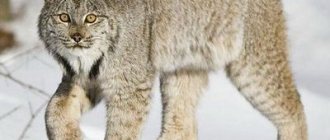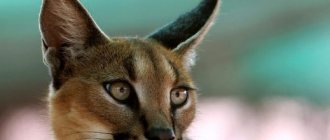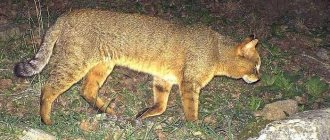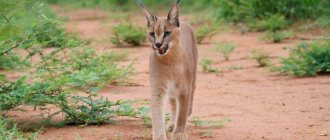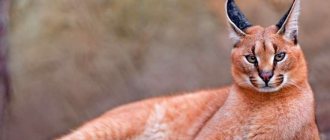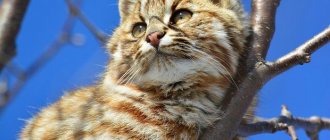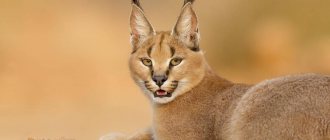- Wild animals
- >>
- Mammals
The cat family is represented by a wide variety of animal species. The Canadian lynx is considered one of the most spectacular and graceful . This is a very beautiful and incredibly majestic animal. The lynx is by nature an excellent predator. These felines have very sharp teeth and claws, giving them a deadly grip. Another feature of this animal is its very long and fluffy fur, because of which the species was almost on the verge of complete extinction.
Description
The Canada lynx has a medium body size and is similar in many ways to the bobcat. The coat color is usually yellowish-brown. The back is darker and the belly is lighter relative to the rest of the body. Many individuals have dark spots. The tail is quite short and ends in a black tip. The lynx's coat is long and thick, protecting the animal well in winter. As cold weather approaches, lynxes grow long “whiskers” that cover their necks. The triangular ears are slightly slanted and have black tufts (about 4 cm long). The paws are quite large and fluffy, thanks to which the weight of the animal is evenly distributed when walking in the snow. The forelimbs are shorter than the hind limbs, like those of the red lynx. There are 4 nipples on the stomach.
The length of the head and body of the lynx ranges from 67-106.7 cm, and the length of the tail is 5-13 cm. Height at the withers varies from 48 to 56 cm. These cats usually weigh from 4.5 to 17.3 kg. Sexual dimorphism is pronounced, males are larger than females. This lynx is almost half the size of the common lynx.
The Canada lynx has 28 teeth and four long canines. The lynx is able to feel with its fangs the place where it bites prey, since they are penetrated by many nerves. It also has four carnassial teeth that grind meat into small pieces. The claws are sharp and fully retractable.
The Canada lynx is distinguished from the bobcat by longer ear tufts, less red fur, less distinct spotting, a shorter tail and larger paws. The red lynx is generally smaller in size than the Canada lynx. The caracal or steppe lynx has ear tufts similar to those of the North American species.
Population and species status
Photo: Predatory Canadian lynx
The Canadian lynx occupies a very important place in the ecosystem. They regulate the number of hares in the habitat region. The number of predators themselves regularly decreases. The main reason for this situation is human activity.
People are destroying animals and their young on an industrial scale. According to zoologists, today the number of animals around the world does not exceed 50,000 individuals. The most numerous populations are observed where the largest concentration of hares is. There are regions where the density of individuals is quite high - up to 35 individuals per hundred square meters.
Poaching is not the only reason for the extinction of the species. People are destroying the natural habitat of animals. They cut down forests, thereby depriving cats of their homes, dooming them to death. Another factor that contributes to the decline in animal numbers is climate change and warming.
People kill cats for their valuable fur. It is highly prized on the black market. The fewer individuals remain in nature, the higher the price for the fur of a predatory beauty rises. Animal meat also has excellent taste characteristics and is somewhat reminiscent of veal, however, in many European countries it is not customary to eat the meat of this animal.
Reproduction
Little is known about the breeding of the Canadian lynx. The home range of a female typically overlaps with that of a male and, occasionally, several females. This distribution, together with sexual dimorphism, indicates that the species is probably polygynous.
The female comes into heat only once a year and, accordingly, one litter is possible. Estrus lasts from 1 to 2 days. Mating occurs in February and March. The gestational period (pregnancy) lasts from 8 to 10 weeks. Females give birth to their young in fallen logs, stumps, wood, or tangles of roots and branches. It is assumed that such shelters protect lynx cubs from potential predators. Typically, a litter consists of 2-3 kittens, although the number of cubs can range from 1 to 5. At birth, lynxes weigh about 200 g and have well-developed hair. Lactation lasts 5 months, but kittens eat meat already at the age of one month.
Males are not caring parents. All responsibilities for raising offspring are assigned to females. Mothers teach their cubs hunting techniques and other life skills. Lynx cubs remain with their mother until the next winter breeding season. Siblings may live together for a period of time after separation from their mother. Females become sexually mature at the age of 21 months, and males at 33 months.
Number
This species is listed in CITES II because it is endangered. At the moment, the number of Canadian lynx is constantly declining because they are often hunted for fur. This also happens because the habitats of these animals are constantly being destroyed, and individuals die while crossing roads. Now the population size is approximately 50 thousand individuals. The maximum animal density is 30 lynxes per 100 square km.
Nutrition
Canada lynxes are strictly carnivores. The American hare is of particular importance in the diet of these cats and occupies from 35 to 97%. Every 8-11 years there is a shortage of hares. If there is no access to hares, they can hunt rodents, birds, moles, squirrels and young ungulates. Canada lynxes eat one hare every one to two days, so each day they eat 0.6-1.2 kg of food. In autumn and winter, lynxes feed on deer and other large ungulates. They also consume carcasses left behind by human hunters.
North American lynxes hunt at twilight or at night, when American hare are especially active. Lynxes rely on their vision and hearing to locate prey. The Canada lynx chases a hare, then pounces on it and kills it with a bite to the head, throat or back of the head. Young ungulates, lynxes, are bitten by the throat and waited until the animal dies. They may eat the prey immediately or hide it in snow and leaves and eat it over the next few days.
How does an animal behave in captivity?
If a Canadian lynx encounters a person in the wild, it will prefer to hide from him, without showing any interest or fear.
Often lynxes settle near populated areas and come quite close to houses, but they will never attempt to get close to a person or attack him.
In captivity, the Canadian lynx lives only in private and public zoos. In the wild, lynxes live for about 10 years, but in captivity they are unlikely to live much longer, even with proper care. They quickly get used to being around people.
If a small lynx is in captivity, it will quickly get used to people, will often be in their company, and allow itself to be petted. However, most of the time the domesticated Canadian lynx will be alone.
Behavior
Canadian lynxes are solitary, territorial animals. Although the home ranges of several females may overlap, males occupy separate territories. A male's home range includes that of one or more females and their young. The size of the occupied territories varies from 11 to 300 square kilometers. Adults tend to avoid each other except during the winter breeding season.
North American lynxes primarily rely on their eyesight, but also have well-developed hearing. Lynxes hunt mainly at night. However, activity can also be observed during the day. They usually stalk prey and then jump on it, although some individuals can ambush their prey for several hours. The lynx is able to walk 8-9 km every day to provide itself with food and moves at a speed of 0.75-1.46 km/h. They are good swimmers and skilled climbers, however, they hunt only on land.
Females and cubs sometimes hunt hares in groups. One lynx scares the prey, and the rest line up and catch it. This hunting method can be very successful and is important in developing hunting techniques among the young.
What does the Canadian lynx eat?
Photo: Canada lynx in winter
By nature, this representative of the cat family is a predator. He is considered an incredible hunter, tenacious, strong, very flexible and cautious. Canadian lynxes feed primarily on hare meat. On average, one adult Canadian lynx eats up to two hundred forest long-eared inhabitants per year. Every day, one adult requires from 0.5 to 1.4 kilograms of food. In the region where predators live, forest hares multiply incredibly quickly, and lynxes regulate their numbers in their natural habitat. Hare meat makes up about 80% of the Canadian lynx's diet. There are other types of living creatures that lynxes feed on.
What can become the object of hunting by the Canadian lynx:
- wild goats, roe deer, deer;
- fish;
- proteins;
- muskrats;
- birds;
- small rodents;
- rams;
- beavers.
In some cases, when the food supply in natural conditions is insufficient, predators can go to human settlements and hunt poultry and other living creatures. In forest areas they can eat the remains of hunters' prey.
Canadian lynxes hunt solely to feed themselves and to obtain food for their offspring. If a predator is not hungry, it will never kill. Lynxes are quite thrifty animals. If they managed to catch large prey, and after satiation there is still food left, the lynxes hide it in hiding places. Caches are made by burying prey in the ground or digging holes in the snow in which the prey is hidden. Such caches are often destroyed by other predators, so cats are left without their supplies.
Predators hunt mainly in the dark. It is at this time that hares are most active and come out of their holes. Cats are able to sense the approach of prey from several kilometers away thanks to their incredible sense of smell. Predators chase prey and pounce in one leap. In most cases they hunt alone. There are cases of group strategic hunting, when young individuals frighten the prey, and the adult female, who is in ambush, grabs and kills it.
Economic significance for humans
Positive
Canada lynxes were hunted for their valuable fur in the seventeenth century. However, after the introduction of restrictions on the trade in the fur of large cats, lynx hunting has decreased significantly. North American lynxes help control the population of small mammals such as American hare and voles, which are agricultural and forestry pests.
Negative
It is not known whether the Canada lynx has a negative impact on human economics.
Where do they live?
The Canadian lynx can be found throughout the meridian. Representatives of this breed live in Canada, Alaska, and the coniferous forests of northern America. Lynx can often be found in states such as Idaho, Washington and Colorado.
Are there any enemies?
In the wild, the Canada lynx is afraid of brown bears. The animal will also prefer to avoid encounters with wolves. But her excellent sense of smell and ultra-fine sense of smell gives her the opportunity to anticipate trouble in advance and prevent a meeting with the enemy. If the meeting was unexpected, the lynx will easily escape from the potential offender due to its ability to quickly climb trees.
